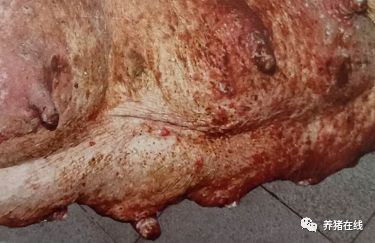How to prevent swine blister disease in pig farms? What's the difference between foot and mouth disease?
A drop in temperature is not necessarily a good thing for pig farms. Pig farmers all know that pigs are more likely to get sick when it is cold. When the temperature drops, it is more likely to cause respiratory disease, diarrhoea, foot-and-mouth disease, blue-ear disease and so on, so we must pay attention to the temperature of the pig house and take precautions.
There is also a disease that occurs frequently at low temperatures, and it is difficult to distinguish from foot-and-mouth disease. It is often mistaken for foot-and-mouth disease, which is pig blister disease. Today we will learn what swine blister disease is, how to prevent and cure it, and how to distinguish it from foot-and-mouth disease.
Cause of disease
Porcine vesicular disease, also known as porcine infectious blister disease, is an acute, febrile, contagious infectious disease caused by enteroviruses, characterized by blisters in the hoof, mouth, nose and around the nipples of sows.

Picture source: disease signal monitoring, diagnosis and treatment dialectics of large-scale pig farm
Live pigs, diseased pigs and their products in the incubation period of swine blister disease are the main sources of infection. When cattle and sheep are mixed with pigs infected with porcine vesicular disease virus, porcine vesicular virus can be isolated from their oral cavity, milk and feces, but they do not have any clinical symptoms. Small wounds or scratches in pigs may be the main route of infection, followed by digestive tract infection. Infected sows may be transmitted to piglets through the placenta.
In actual cases, most of the pig blister disease is related to feeding contaminated food (such as hogwash, meat washing water, etc.), contact with contaminated sites and transport vehicles, or the introduction of sick pigs. The outbreak of swine blister disease has no obvious seasonality and occurs frequently in cold season. Pigs of different breeds and ages are easy to be infected, but the incidence of blister disease is low.
Symptomatic form
The incubation period of swine blister disease was 2 mi 6 days, the incubation period of contact infection was 4 mi 6 days, and the incubation period of infected pork products was 2 days.
The first observation was that a few pigs in the herd developed claudication. While walking on hard ground is more obvious, and often bow back walking, pain response, or lying on the ground can not afford, the larger the pig is more obvious, the body temperature generally increased by 2 ℃ 4 min.
The injury usually occurs in the crown of the hoof and between the hooves and forks, which may be caused by single hoof or multi-hoof. The skin appears blister and rupture, and can be extended to the bottom of the hoof, some accompanied by hoof shell loosening, or even shelling. Blisters and secondary ulcers may also occur in the nose, oral epithelium, tongue and nipples. General contact infection after the incubation period of 4 days, primary blisters, contact infection can occur within 2 days, sick pigs can generally return to normal in 3 weeks.
The incidence varies greatly at different outbreak points, some no more than 10% and some up to 100%. The mortality rate is generally very low, the experimental infection of lactating sows, the morbidity and mortality of suckling piglets are very high. Infected pigs with clinical symptoms and diseases exposed to them can produce high titers of neutralizing antibodies and can last for at least 4 months.
Pre-prevention
1. Forbid unboiled hogwash to feed pigs, choose nutritious full-price materials, and pay attention to balanced nutrition when preparing self-made feed. Good feed is the basic requirement for pigs to maintain normal resistance, and nutritionally balanced feed can also prevent bites and pica caused by lack of trace elements.
2. Vaccination. The kidney-transmitted cell attenuated vaccine of porcine blister disease was inoculated to prevent the disease. For large and small fat pigs, 2 ml was injected into the deep thigh muscle. 5 days after injection, strong immunity could be produced, and the immune period was 6 months.
3. Reduce stress in pigs. When turning and transporting, it is necessary to ensure a clean and hygienic environment, suitable temperature and humidity, stress will cause a rapid decline in pig resistance, and the risk of infection of various diseases will be greatly increased.
4. Reduce the injury of pigs. The smoothness of the ground is moderate, and too rough cement ground will increase the possibility of pig's hoof damage. Often check the enclosure, remove the hidden dangers of safety, and deal with the iron wire thorns that are easy to hang and scratch pigs in a timely manner.
Treatment and treatment
The sick pigs should be isolated immediately and choose appropriate drug treatment.
Systemic treatment combined with drugs, can use astragalus polysaccharides, Radix Isatidis and other antiviral Chinese medicine combined with amoxicillin, cefotaxime sodium and other antibiotics, once a day, continuous use of 3mi for 5 days, can play a good rehabilitation effect.
Local treatment can choose 20% iodine glycerin, 1% methyl violet solution, 5% iodine tincture solution, choose one of them, rinse the patient site, and then smear chlortetracycline, purple grass, amoxicillin, vaseline and other self-made ointment twice a day for 7 days, which can shorten the course of disease and reduce mortality. Malignant cases in addition to the above treatment, but also do a good job of cardiotonic, supplementary nutrition, can promote the recovery of sick pigs.
Differentiation from foot-and-mouth disease
Swine blister disease is characterized by strong epidemic, high incidence, blisters in hoof, mouth, nose and abdomen, skin and mucosa around nipples. The clinical manifestation showed that the incubation period of the disease was 2mi 4 days, and the changes of body temperature and lesions of hoof and mouth were similar to those of foot-and-mouth disease. In addition, a few pigs showed symptoms of central nervous disorder, such as rushing forward, turning around, rubbing the doorpost with the nose, gnawing utensils, eye movements, and sometimes ankylosing spasm.
However, foot-and-mouth disease can cause acute gastroenteritis and myocarditis, acute failure and death in piglets, and the fatality rate is high. Adult pigs have blisters or ulcers in the hoof, oral mucosa, nose, skin and breast, and the fatality rate is low.
Picture source: disease signal monitoring, diagnosis and treatment dialectics of large-scale pig farm
From an economic point of view, swine blister disease generally has only a slight impact on pig fattening plans, the morbidity and mortality are not as high as foot-and-mouth disease, and the recovery rate is faster than foot-and-mouth disease.
It is worth noting that the importance of foot-and-mouth disease vaccine is higher than that of blister disease vaccine, so pig farmers usually vaccinate the whole herd of pigs against foot-and-mouth disease vaccine every October.
Conclusion: porcine foot-and-mouth disease and porcine blister disease are both viral diseases, and their clinical symptoms are very similar, so their treatment methods are also very similar. During the treatment, antiviral traditional Chinese medicine and antibiotics are selected to eliminate fever and other systemic symptoms, festering parts are cleaned and disinfected in time, and nursing care for piglets should be strengthened.
- Prev

This is the symptom and prevention of blue ear disease in pigs. Don't get it wrong again.
This is the symptom and prevention of blue ear disease in pigs. Don't get it wrong again.
- Next

How to prevent and cure yellow dysentery during the period of feeding and management of piglets?
How to prevent and cure yellow dysentery during the period of feeding and management of piglets?
Related
- On the eggshell is a badge full of pride. British Poultry Egg Market and Consumer observation
- British study: 72% of Britons are willing to buy native eggs raised by insects
- Guidelines for friendly egg production revised the increase of space in chicken sheds can not be forced to change feathers and lay eggs.
- Risk of delay in customs clearance Australia suspends lobster exports to China
- Pig semen-the Vector of virus Transmission (4)
- Pig semen-the Vector of virus Transmission (3)
- Five common causes of difficult control of classical swine fever in clinic and their countermeasures
- Foot-and-mouth disease is the most effective way to prevent it!
- PED is the number one killer of piglets and has to be guarded against in autumn and winter.
- What is "yellow fat pig"? Have you ever heard the pig collector talk about "yellow fat pig"?

